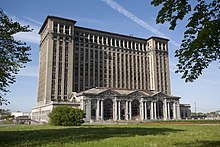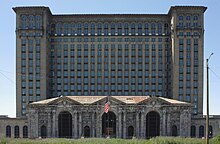Michigan Central Station
Michigan Central Station ( Michigan Central Depot or MCS ), built from 1910 to 1913, is an under monument protection standing, but for decades to decay due monumental train station in the city of Detroit in the US state of Michigan . During the construction period it was the tallest station building in the world.
location
It is in the Corktown district of Detroit near the Ambassador Bridge , about two miles southwest of downtown. In front of the building there is a larger park, Roosevelt Park. It was hoped that this somewhat decentralized location would improve the surrounding districts, but the hoped-for upturn never took place. The monumental but isolated building has been on the National Register of Historic Places since 1975. Various maintenance and renewal projects have always failed so far.
history
The first plans for the building were made as early as 1906 when construction work began on an underwater tunnel, the Michigan Central Railway Tunnel , to Windsor in southwest Detroit. A new, much larger depot than the previous one in the center of the city was to mark the entrance to the tunnel. The previous terminus (1885-1913) no longer met the requirements of the growing railway company. In 1908 the purchase of land around the current station building began. A year and a half later they had a plot of land about five hectares in size, in which about 300 houses had been bought or people had been expropriated. The city bought the area in front of the building (1915) to create a large park, today's Roosevelt Park . This was exemplary for the time when prestigious green spaces were built in large public buildings.
Construction of the new building began on May 16, 1910 after the Michigan Central Railroad , a subsidiary of the New York Central Railroad , commissioned the architects 'Warren & Wetmore' and 'Reed & Stem'. Both of them had already built Grand Central Station in New York together. Reed & Stem became known through the construction of numerous train stations, Warren & Wetmore rather through hotel designs, which also characterizes the facade of the 18-story high-rise office building. The simple addition and juxtaposition of the two main building parts (office tower and entrance hall) triggered numerous discussions at the time and generated clear criticism.
The neoclassical building was the tallest station building in the world at the time and the fourth largest in Detroit. It was to be officially opened on January 4, 1914. This opening never took place, however, as a fire in the existing station on December 26, 1913 made it unusable. Operations in the new station began while the fire was being extinguished. The first train left the building for Chicago.
The station was deliberately built 3.7 kilometers (2.6 miles) from the city center. It was supposed to be the initiator of a new urban area, an area that was previously poorly developed and was called a slum. It was intended to expand the city center towards the west and thus upgrade this area. However, that never happened.
In the early days of operations, it was not a problem that the station could be found far outside. The local public transport network brought people directly to the east entrance of the building. It was therefore the most frequently used entrance to the building. A tram terminal was located here. The representative main entrance with large arched windows in the north was rarely used. In the early days of the station, the automobile did not play an important role. This can be seen in the lack of parking facilities, which later caused problems for the station. Trams (streetcars) and interurban buses were used for the surrounding areas.
When Henry Ford began buying up land around the train station in the 1920s to build a large business center, the area was facing a potential upgrade. Shortly afterwards, however, any ambitions of further investors were stifled by the Great Depression . In the years that followed, the long-distance buses ceased operations, and finally, due to the increasing popularity of the car in 1938, the tram connection to the center also ceased. The number of passengers only fell dramatically after 1945. The complete lack of parking spaces made the station less attractive and fell into an increasingly isolated position far away from the population.
The station experienced an upswing through the Second World War, in which it served as a hub for military machine and soldier transports. However, the number of visitors quickly changed again after the end of the war. The state-subsidized expansion of motorways and the increasing domestic air traffic also contributed to the decline in passenger numbers.
While in World War I, at the height of rail travel in the United States, more than 200 trains a day left the station, in the 1940s more than 4,000 guests used the waiting area and 3,000 people worked in the office tower seven days a week In the 1950s, numerous areas were gradually reduced in size (the restaurant was halved, the vaulted ceiling in need of restoration was suspended with a coffered ceiling) and closed to the public (the former waiting room was now used as a warehouse). An attempt to sell the station in 1956 for US $ 5 million, a third of the 1913 construction cost, failed, as did another attempt to sell it in 1963. In 1967 the station was partially closed, namely the main entrance, shops and that Station restaurant.
Amtrak's takeover of passenger transport in 1971 brought a brief period of hope. The main entrance and large waiting room reopened in 1975, and major repairs were carried out in 1978. In 1984 the building was sold to a transport company. On January 6, 1988, the last Amtrak train left the station for Chicago. In the years that followed, the building changed hands several times, once for less than $ 80,000. Ideas for a possible conversion and subsequent use could not be implemented due to excessive financial hurdles or legal concerns. A customs trade center, a convention center, hotel, office park, a train station with high-speed trains, a casino and the Detroit police headquarters were possible uses. From 1996 to 2018 it was owned by Controlled Terminals Inc., a company controlled by Manuel Moroun . He was listed at number 296 on Forbes' list of the richest Americans in 2009. Again and again this condition of the building causes numerous discussions in the public and the press when it comes to possible suggestions for a re-use of the building.
In June 2018 the building was acquired by Ford Motor Company .
Current situation
On April 7, 2009, the city council, which had previously refrained from any kind of renovation due to the high costs, approved the demolition of the building. The measure should be financed with funds from the federal government's economic stimulus package. As a result, a Detroit resident sued the city and demanded that the building be retained because the demolition would violate the National Historic Preservation Act of 1966 . In September 2009, the Michigan Central Station Preservation Society was founded with the goal of preserving the building.
For 25 years the building has been a playground for vandals, homeless people, sprayers and junkies, as the current condition of the building shows. In addition, it is always a place for filming ( Transformers , The Island , Four Brothers and 8 Mile ) and a contact point for foreign reporters (see also Michigan Theater ).
Urban planners now see the area around Michigan Central Station as a key position in bringing people from Canada to downtown Detroit. The Ambassador Bridge , the main connection to Canada, can, by upgrading the Mexicantown and Corktown districts, lead people into the city center instead of using the motorway. The building has been cleaned up and repaired since spring 2011.
Individual evidence
- ↑ Kavanaugh, Kelli B .: Detroit's Michigan Central Station (Images of America) . Arcadia Publishing, 2001, ISBN 0-7385-1881-6 .
- ↑ Harold D. Eberlein, published in Architectural Record, Volume 36, 1914 and in "Trains, Volume 38, Kalmbach Pub. Co., 1978:" The exterior of the Detroit Station presents an extraordinary lack of continuity of conception. Seen from a distance, the casual observer, unless otherwise informed, would never take the two parts of the station to be portions of one and the same building, so utterly different are they. Each part taken separately might be good. Joined together, they are architecturally incongruous . "
- ↑ Forbes detail page . Retrieved January 27, 2011
- ↑ Manuel J. Mooren, who suggested a casino project at this point at the time of the purchase, now answers the question of a possible use “I hate being associated with that, what the hell am I supposed to do with it? I can't sell it, and I won't give it away for a dollar. I can't redevelop it. Who would want to go in there? Nobody. There's no reason. That's throwing money to the wind. Can't tear it down, it's an historic landmark. "; from the Detroit News of December 15, 2008
- ↑ Fitch, Stephanie and Joann Muller (11-15-04). The Troll Under the Bridge . Forbes.Retrieved January 27, 2011.
- ↑ Archived copy ( memento of the original from October 6, 2011 in the Internet Archive ) Info: The archive link was inserted automatically and has not yet been checked. Please check the original and archive link according to the instructions and then remove this notice.
- ↑ Confirmed: Ford bought Michigan Central Station . In: Curbed Detroit . ( curbed.com [accessed June 12, 2018]).
- ↑ Associated Press: Detroit man sues to block demolition of rail depot . In: fox28.com . April 14, 2009. Retrieved on March 25, 2010. ( Page no longer available , search in web archives ) Info: The link was automatically marked as defective. Please check the link according to the instructions and then remove this notice.
- ↑ SaveMichiganCentral.com . Retrieved March 25, 2010.
- ↑ http://einestages.spiegel.de/external/ShowTopicAlbumBackground/a19941/l0/l0/F.html#featuredEntry Abandoned Detroit, The Wreck Instead of One Day
- ↑ Archived copy ( memento of the original from January 23, 2011 in the Internet Archive ) Info: The archive link was inserted automatically and has not yet been checked. Please check the original and archive link according to the instructions and then remove this notice. A New Key Location for Michigan Central Station, TheDetroitNews, Nov. 8, 2010
- ^ The Detroit News, Aug. 25, 2011, Dusting off the depot: Moroun making good on cleanup
Web links
- Texts and photos to Forgotten Detroit
- Excerpt from the book by Kelli B. Kavanaugh, 2001
- Short video from the Detroit Free Press on the current state of the building
- 'Ruins of the Golden Age'
- Seeking a Future for a Symbol of a Grander Past, New York Times
- "Detroit, a ruin of the automobile age" , Nora Sobich, published on Stylepark.com
Coordinates: 42 ° 19 ′ 43.1 ″ N , 83 ° 4 ′ 40.1 ″ W.



